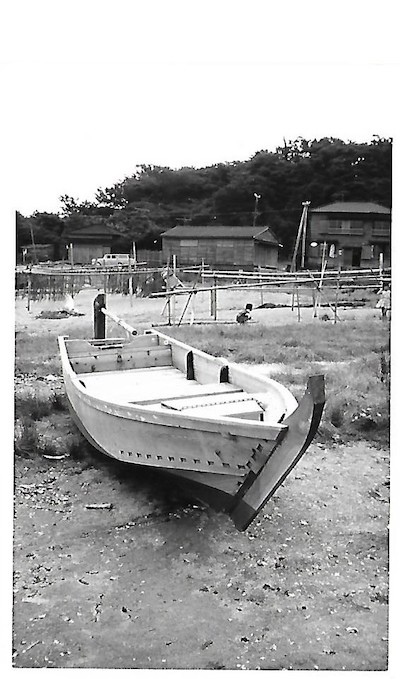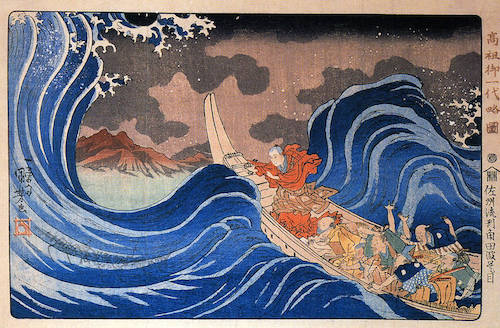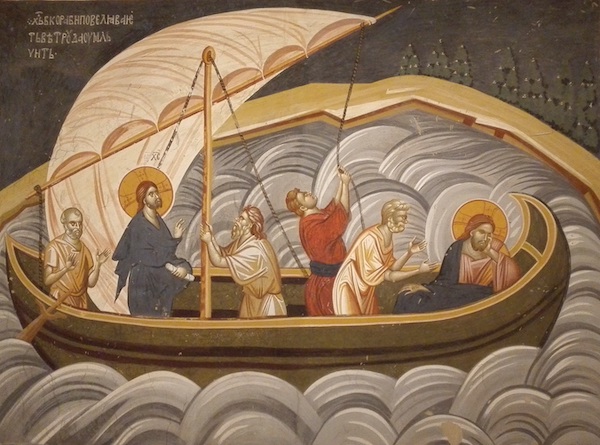Dan Reid, Associate Fellow of the KLC, retired academic and IVP Academic reference book editor; sailor and lover of wooden boats, is currently writing a book on Protestant missionary work in the late-nineteenth and early-twentieth-century China, based on his family’s experiences.

A fresh breeze blows out of the north. The forty-year-old diesel engine chugs its rhythmic beat as I head out from the marina. I turn the sailboat into the wind. Scrambling forward over the cabin, I winch the mainsail up the thirty-foot mast. I secure the halyard to its cleat. Quickly, back to the tiller, I reset the boat into the wind, and from the cockpit I winch the foresail halyard until the jib is set, then cleat it securely. I cut the engine. The sails ruffle, then fill with a crack. The jib-sheet block creaks. And a sweet quiet descends as the boat heels, and the water laps and burbles along the hull. We plough a furrow out into the bay while snow-capped peaks frame the horizons. In those moments I slip into an experience shared by mariners over thousands of years.
My dad introduced me to boats. A few years after we arrived in Japan in 1953, his relief from the pressure of missionary work was to go down to the sea. First it was a sailboat on Tokyo Bay. Then a little runabout with an outboard engine. And finally, a traditional Japanese wooden fishing boat, built and kept in a little fishing village on Sagami Bay.
I recall the boat-building shop in the village of Hamamoroiso. Barely one hundred yards from the beach we enter the domain of a father and son boat-building enterprise. There is room to build one boat at a time. Specialized boat-building saws, chisels and planes – neatly sharpened, well worn – are the signature of the trade. Wood shavings as thin as parchment snake and coil on the dirt floor. There is one electric saw. A rude intrusion of modernity, it had required the missing half of one of the old man’s fingers. Otherwise, tradition rules in this shop. For the craft of Japanese boat building extends back hundreds of years, with elements borrowed from China and honed to Japanese perfection.
Most of the fishing boats winched up on the sands of Hamamoroiso had been built in this shop. The boat trade was integral to the convivial life and economy of the village. The fishermen tending their nets offshore, the women diving for abalone and sea urchins, they and their ancestors, all had depended on the skills of generations of these village boat builders.

But as a teenage American boy, I had little notion of the stream of tradition we were floating in, we with our forty-horsepower Evinrude outboard. But I now marvel at it all. And I am surprised to recall snatches of a Japanese sea shanty I first heard sung by a boat crew on Sagami Bay.
Until very recently I lived in a seaside town on Washington State’s Olympic Peninsula, on the shore of the Salish Sea. It is well populated with sailors, boat builders and riggers, some of them deeply accomplished and widely known in boat-building circles. The teeming boatyard holds a mix of pleasure and working boats. Alaskan fishing vessels of up to three hundred tons are plucked from the water and set “on the hard” for maintenance, repairs and refurbishing. A good number are older wooden vessels, kept in service. The old work of steaming planks and pounding oakum into seams still goes on. Wooden boats can be maintained for a century and more. And here the trade is kept alive. At the north end of town, the skills of wooden boat building are practised and taught in a community boat centre. A few miles down the bay, a school of wooden boat building sustains the trade. From fishing Alaskan waters to sailing our local bay, a well-built boat matters.

The town hosts an annual Wooden Boat Festival, with wooden boats of all descriptions coming from around the Pacific Northwest. People flock to this festival, both to admire and to learn how to build, maintain and sail wooden boats. Seminars abound, old salts and young adventurers mingle, and dreams of boats and voyages take hold. The old traditions still hold their grip.
A few years ago, an American boat builder, who had apprenticed under the last remaining Japanese wooden boat builders, was invited to the Wooden Boat Festival. I showed him a picture of our wooden boat of the 1960s, winched up on the sands of Hamamoroiso. From him I’ve learned more about the craft of Japanese wooden boat building.(1) And I am grateful for my youthful brush with those village tradents of boat-building wisdom. From the choice of tree, to the favoured cuts of wood, to the precise joints and mortises, and the specialized tools and measuring instruments, it is a practical wisdom embodied in the builders and extended to the objects of their attention. So cunning is the craft of Japanese boat building that the seams between planks are not caulked, but cut and fitted precisely so that they are watertight at the joints.
The old boat builders do not lecture their apprentices, nor do they invite questions. They do not package their cisterns of boat-building wisdom into lesson plans. The disciples are to be silent, to watch closely, to do as they are told, no matter how menial the task. Gradually, processes and subtle secrets are revealed through demonstration and keen observation. Skills are embodied through practice. Craft is ingrained in habit. This same cultural pedagogy may be seen in the documentary film Jiro Dreams of Sushi. The sushi apprentice takes some two hundred tries before he earns the master’s nod. He has finally done the egg (tamago) right. And he weeps.

Three generations before me travelled by wooden boats of East Asian design and build. In 1936 my mother, her parents, and younger siblings took to a Chinese coastal junk as they fled from Japanese imperial forces. In the 1890s and beyond, my great grandparents and grandfather travelled up and down China’s Grand Canal in wooden boats. And in those years they saw the last of the celebrated imperial rice fleet moving up the Grand Canal, banners flying, sails billowing in the spring breeze as they annually processed northward to Peking. All of these wooden boats were made by builders of great skill, their trade passed down in streams of tradition. For China moved on boats. And my ancestors were debtors to that boat-building tradition.
The Gospels portray fishermen and their wooden boats on the Sea of Galilee. Peter and his fellow fishermen are boatmen. They know how to work with the forces of wind and water, with the grain of creation. Their Teacher is an upland artisan from Nazareth, with a keen eye for stem and keel, futtocks and planking. Somewhere off the Gospel page – in Capernaum or Bethsaida or Magdala – boat builders of local renown are practising their trade. The boats of the Gospels are transport, livelihood, and more: A figure of the church, bearers of the Word, crucibles of faith, passages through the storm.

The Japanese artist Hokusai’s print, The Great Wave off Kanagawa, is a global icon. Three boats and their terrified crews are dwarfed by a monstrous rogue wave breaking high and framing Mount Fuji in the distance. Mountain and sea, two archetypes in the metaphysical topography of East Asia, overpower the human subjects and their craft. The towering wave arches over them, clawing like a dragon. Cypress and cedar, hewn from mountainsides and shaped into boats, are suspended in perilous tumult. And Mount Fuji, the sacred mountain, hovers on the horizon in serene symmetry.
Also from the nineteenth century, a print by Utagawa Kuniyoshi has the Buddhist monk Nichiren standing in the bow of a boat overshadowed by a towering wave. With hands extended and robes flying in the wind, Nichiren commands the sea, while boatmen and passengers scream in terror. In the background, a mountain stands in dark and brooding witness.
In another time and place we encounter a wooden boat in peril on the Sea of Galilee. The wind shrieks, the wooden vessel descends into the troughs of mounting, foam-capped waves. The best of Galilean boat building is thrust to its margins, and the crew cries out. It is the craftsman from Nazareth who stills the storm. And on the northern horizon, snow-crowned Mount Hermon, storied in Israel’s imagination – “Tabor and Hermon rejoice in thy name!” (Hos 14:5) – looks on.
Hamamoroiso and the waters of Sagami Bay, where we plied our wooden boat, looked out on that same view of Mount Fuji as Hokusai’s print. Our boat was a smaller version of those portrayed. We were fair-weather sailors, taking to the sea for its pleasure. I recall no anxious moments on Sagami Bay. But from China in 1921, my missionary great-grandfather closes a letter to churches in America:
I have been writing this under some drawbacks; I am on an itinerant trip. All day we have been out on a large lake, twenty by forty miles, fighting against a heavy head wind. All this afternoon, the men have been rowing hard to make a harbor before dark. The boat is a little cockle shell of a thing and is being tossed about like a chip – a word in your ear – I shall be glad and feel much easier when we cast anchor inside the breakwater which I see a half mile off to our starboard.

I think of that “little cockle shell of a thing,” its wood hewn from the mountains of Shandong, its boat-building tradition and skills passed down through generations, and how much it all mattered. Bobbing, tossing over the long fetch of wind-churned waves, the boat finally reached its snug harbour. It bore the gospel across the lake. The Word was planted. And it still flourishes today.
Today we live in a world increasingly removed from hewn wood, hand saws and traditions of the past. Even the late-model cars we now drive are increasingly inured from the tune-ups and probing wrenches of shade-tree mechanics. My sailboat’s old Volvo marine diesel engine was a relic of the 1970s. I could learn its ways, reach into its oily bowels, and elicit a satisfying huffing-chuffing response to my novice efforts. The sailboat was not wooden but fibreglass – I shamefully admit – but at least it was hand-laid fibreglass, a “plastic classic” in the generations of late-twentieth-century boat production. From rudder to rigging, it was a recognizable extension of thousands of years of sailing. A materialized conversation and argument within its stream of craft and tradition.
A recent article in The Washington Post tells how some Silicon Valley tech workers are finding gratification in crafts such as woodworking. Inhabitants of the corporate ethos of “move fast and break things,” of clicking keyboards, silicon chips and blue-lit screens, they are learning the deeper gratification of finding themselves in woodworking, in glassblowing, in pottery making. In the San Francisco area, woodworking shops are springing up. One couple, investing their spare time in woodworking, is making the dining-room table “we’re going to die with.” And in Japan, there is renewed interest in the traditional craft of wooden boat building. The human need to work with our hands, to create, to alter, to tangibly shape natural materials into things beautiful and useful runs deep. Beneath the pixilated scrim of modernity lies a human impulse and yearning that will not be denied.
In The World Beyond Your Head, Matthew Crawford tells of organ makers in Virginia. They are deeply conscious of working in a tradition reaching back hundreds of years, and their own work is in conversation with their forebears. Whatever their innovations, they are a sustained argument with their tradition. It drives them to ask, “What will the results of my actions be four hundred years from now?” An arresting question in our consumer-driven, throw-away society of “model years” and planned obsolescence.
Japanese traditional wooden boat building inhabits an animistic spiritual tradition, Shintoism. That world is suffused with kami, spiritual forces, gods. And in this context, the craft of Japanese boat building emerges as a public theology of sorts. In an important sense it is far more akin to the Christian tradition than the atomized and spiritually denuded world of modern materialism. At its launching a boat is ceremonially consecrated, and the deities of mountain and of sea are addressed. Artisan and craft, wood and water, transport and navigation are suffused with spiritual meaning. It is rooted in a particular understanding of the spiritual dimensions of the natural world.

For Christians there are not many gods but one triune God, creator of heaven and earth, of mountain and sea. And that which God creates is not finished, as if it were an object nakedly suspended in space and time, independent of its creator. The incarnate Son of God, the woodworker from Nazareth, who from a wooden fishing boat commands the wind and waves to cease, holds fast the wooden boat in its sinuous grain. For in him all things are held together. The extension of the human mind through hands and tools and wood is a creative and spiritual extension of our own God-created being, and thus – in a real sense – an extension of God’s creative act. The one who shaped wood in Nazareth puts his signature on this work.
As Peter Leithart puts it, “Mind comes to its perfection as mind not by isolating itself in its own cogito, but by reaching beyond itself into the external world and accepting the outer world into itself.” We are not locked in the prison of Descartes’ cogito ergo sum, “I think, therefore I am.” “We discover ourselves in extending beyond ourselves.”(2) And that extension includes the material of the world around us. That world beyond our head is created and sustained by the Creator God, and we enter into that divine creativity. For “from him and through him and to him are all things” (Rom 11:36). God sings the world into being and sustains it with his song.
Among the forgotten spiritual and theological resources in our Christian tradition are the prayers for mariners facing storms at sea. These are found in old editions of the Book of Common Prayer. For in a gale, piety surges. But we must also recover the tradition of blessings of craftspeople, of St Brendan, the patron saint of builders of coracles, and clippers, and cockle shells. For in the high gale of virtual reality and artificial intelligence, we must catch the tune of the Creator and sing along.
The Kirby Laing Centre for Public Theology in Cambridge. Charity registered in England and Wales. Charity Number: 1191741
Kirby Laing Centre, The New Mill House, Unit 1, Chesterton Mill, French’s Road, Cambridge, CB4 3NP
© 2022 The Kirby Laing Centre for Public Theology in Cambridge